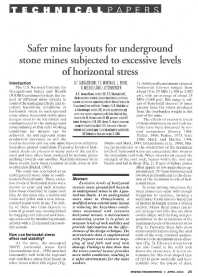Mining Publication: Safer Mine Layouts for Underground Stone Mines Subjected to Excessive Levels of Horizontal Stress
Original creation date: April 2003
Excessive levels of horizontal stresses cause ground-fall hazards in underground mines in the Appalachian Basin. At an underground stone mine in Pennsylvania, a modified stress-control mine layout is reducing the hazardous conditions associated with excessive horizontal stresses. A microseismic monitoring system is in place to measure levels of rock stability and provide information on the effectiveness of the design technique. The microseismic data are supplemented with frequent and extensive mapping of roof falls and roof rock damage. Findings to date show that the stress control layout provides more stable conditions, resulting in a safer environment for the mine workers.
Authors: AT Iannacchione, TE Marshall, LM Burke, R Melville, J Litsenberger
See Also
- Advance and Relieve Mining: A Method to Mitigate the Effects of High Horizontal Stress on the Mine Roof
- Effect of the Dip and Excavation Orientation on Roof Stability in Moderately Dipping Stone Mine Workings
- Horizontal Stress
- Horizontal Stress and Longwall Headgate Ground Control
- Local Earthquake Tomography for Imaging Mining-Induced Changes Within the Overburden above a Longwall Mine
- Preventing Falls of Ground in Coal Mines With Exceptionally Low-Strength Roof: Two Case Studies
- The Relationship of Roof Movement and Strata-Induced Microseismic Emissions to Roof Falls
- Temporal Imaging of Mine-Induced Stress Change Using Seismic Tomography
- Three-Dimensional Time-Lapse Velocity Tomography of an Underground Longwall Panel
- Time-Lapse Tomography of a Longwall Panel: A Comparison of Location Schemes
- Variation of Horizontal Stresses and Strains in Mines in Bedded Deposits in the Eastern and Midwestern United States
- Content source: National Institute for Occupational Safety and Health, Mining Program


 ShareCompartir
ShareCompartir
